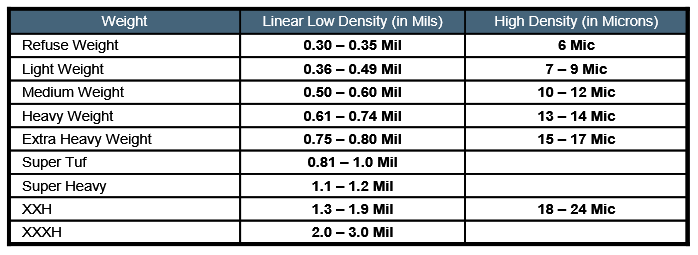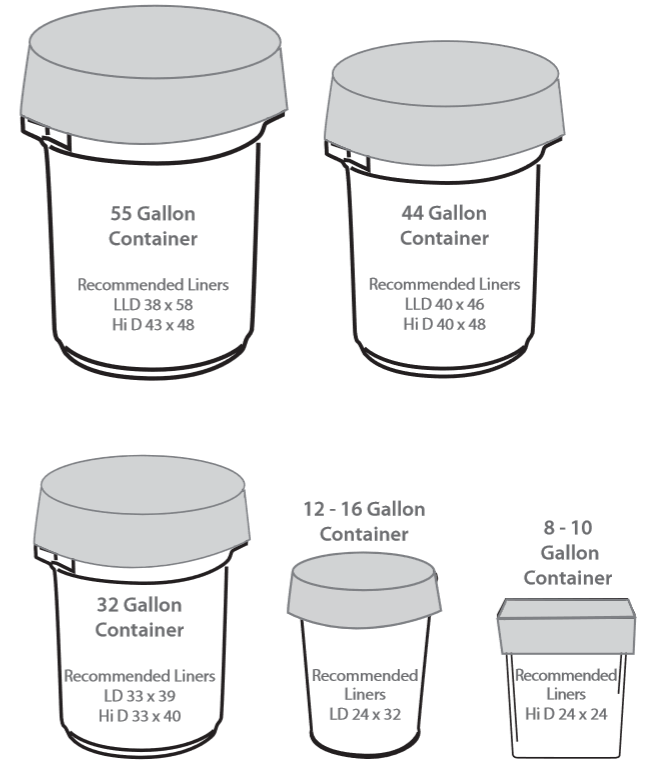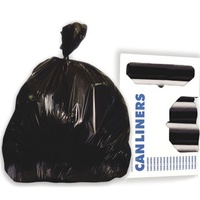Choose bag size and bottom seal of the liner based on type of trash can being used. Some manufacturers will state liner sizes in “gallons” in an attempt to offer smaller liners that use less plastic. Most manufacturers use the item number to indicate the liner size even though it is not the actual size of the liner.
Film thickness is no longer the only standard for judging overall bag strength.The development of advanced resins and additives has changed the standard method for selecting the correct can liner. Manufacturers are producing thinner, lighter trash bags that are stronger and more durable than thicker bags made from lesser quality raw materials.
Verify the gauge or thickness of the liner. Some manufacturers avoid stating the actual thickness of the liners, an attempt to sell less plastic for a higher price. There is no governing agency to ensure that thicknesses listed on the carton is what is actually in the box. Weighing the case and comparing against other brands will help identify any differences. Less weight equals less plastic. Many manufacturers will test liner samples in their lab to give you the actual mill/mic thickness of a competitive product for comparison purposes.
Check how many liners are in the case and calculate the cost per can liner pricing. Fewer liners in a case gives the appearance of a better value because of the lower price. Calculating the cost per can liner will give you the true cost per use.
Plastic Type
High-Density (HD)Trash Liner
- Makes “crinkly” noise when you move it – like a supermarket bag
- Harder to start or puncture a hole in than Low Density (LLD)
- Once a hole is started, will spread quickly or “zipper”
- Thinner than LLD, but can hold sameor greater weight as LLD liners
- Gauge (thickness) measured in Micron (MIC)
- Some suggested applications: cans without edges, paper, food, smooth heavy objects
- Substantial cost savings on a per-liner basics
Linear Low-Density (LLD)Trash Liner
- Quiet when moved – No “crinkly”sound
- Easier to start or puncture a hole in than HD
- A hole will spread less quickly than HD
- Gauge (thickness) measured in MIL
- Most common type in the industry
- Multipurpose applications – recommended for sharper objects and tough transport conditions
Repro Trash Liner
- Reprocessed or made from recycled material
- The EPA’s Comprehensive Procurement Guideline recommends 10-100% post-consumer recycled content
- Lower capacity for weight... but at a lower cost
- Thicker repro bag is needed to lift the same amount of static weight as a virgin resin bag
Bottom Seals
Star Seal
- Star sealed can liners are the most expensive and highest quality since they conform better to larger, round trash cans.
- Most common type in the market
- Bottom of the bag looks like a star or appears “bunched up”
- Conforms better to larger, round trash cans
- Minimum leak potential
- Most expensive and highest quality
- Star seal liners are designated by two dimensions (i.e. 40 x 46)
Gusset Seal
- Gusset sealed bags are the least expensive and will tend to leak, unlike star seal or flat seal
- A flat style bag
- Both sides are tucked in which forms a gusset
- If bag is lying flat it will have a third dimension like an expandable envelope
- Conforms reasonably well to the shape of the trash can
- May leak – potential for weak bottom
- Least expensive
- Gusset seal liners are designated by three dimensions (i.e. 23 x 17 x 46)
Flat Seal
- Bag will lay out perfectly flat like a tube with a seal on one end or resemble a pillow case
- Does not conform to the shape of the trash can
- Holds 20-30% more than a star sealed
- Medium leak potential
- Flat seal liners are designated by two dimensions (i.e. 40 x 46)
Static Load
Static load (lifting strength) is the best way to choose bag strength. Approximate gauge equivalents for static load are...

Strength Grade Key
In general, use light to heavy gauges for smaller cans; Extra Heavy to Super Heavy for midsize/large cans; Super Heavy to XXXH for very large cans.

Film Colors
- Black, white and natural are the most common
- Natural (otherwise clear or transparent) are ideal for areas where transparency is required for security purposes
- Specialty colors (red, yellow, blue, brown, gray) are ideal for at-a-glance content identification (i.e. blue bags may indicate recyclable waste)
Size of the Trash Liner
Some manufacturers will state liner sizes in “gallons” instead of dimensions inan attempt to offer smaller sized liners that use less plastic. Most manufacturers use the item # to indicate the liner size, that’s not always the case!. Don’t be fooled by the item #, check the actual size on the box.
2 dimension (i.e. 38x60)
- Used with Star, Flat and occasionally Gusset seal bags.
- 38 = face (17) + depth (21) of the bag
- 60 = height of the bag
3 dimension (i.e. 17x21x60)
- Used only on Gusset seal bags
- 17 = face of the bag
- 21 = depth of the gusset
- 60 = height of the bag
Most Common Cans & Recommended Liner Sizes



